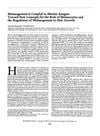TLDR Silencing certain circadian clock genes increases skin pigmentation.
The study by Hardman et al. (2015) demonstrated that silencing BMAL1 and PER1, components of the peripheral circadian clock, increased melanogenic activity in human hair follicles and skin melanocytes, evidenced by increased pigmentation, expression of tyrosinase and related proteins, and enhanced melanosome transfer to keratinocytes. The findings suggested that peripheral circadian rhythms played a significant role in regulating melanin pigmentation and skin physiology, opening new avenues for dermatological research and potential treatments for pigmentation disorders and melanoma.
 81 citations
,
October 2014 in “The journal of investigative dermatology/Journal of investigative dermatology”
81 citations
,
October 2014 in “The journal of investigative dermatology/Journal of investigative dermatology” Certain genes control the color of human hair by affecting pigment production.
 116 citations
,
May 2013 in “Proceedings of the National Academy of Sciences of the United States of America”
116 citations
,
May 2013 in “Proceedings of the National Academy of Sciences of the United States of America” Hair grows faster in the morning and is more vulnerable to damage from radiation due to the internal clock in hair follicle cells.
 252 citations
,
January 2008 in “Trends in Endocrinology and Metabolism”
252 citations
,
January 2008 in “Trends in Endocrinology and Metabolism” Melatonin in the skin helps protect against damage from stress and UV rays, and could be used to treat certain skin conditions.
 210 citations
,
July 1993 in “The journal of investigative dermatology/Journal of investigative dermatology”
210 citations
,
July 1993 in “The journal of investigative dermatology/Journal of investigative dermatology” Hair color production in mice is closely linked to the hair growth phase and may also influence hair growth itself.
 109 citations
,
July 1993 in “The journal of investigative dermatology/Journal of investigative dermatology”
109 citations
,
July 1993 in “The journal of investigative dermatology/Journal of investigative dermatology” Hair color production is closely linked to the active growth phase of hair in mice and may also influence hair growth itself.
6 citations
,
March 2022 in “International journal of molecular sciences” Natural skincare products may help reduce sun damage and support the skin's daily cycle.
 June 2025 in “Clinical Cosmetic and Investigational Dermatology”
June 2025 in “Clinical Cosmetic and Investigational Dermatology” Gray hair can potentially be managed or reversed with treatments that boost melanin production and address nutritional deficiencies.
 12 citations
,
May 2023 in “EMBO reports”
12 citations
,
May 2023 in “EMBO reports” High mTORC1 activity slows hair growth and causes it to lose color.
 30 citations
,
March 2015 in “PLoS ONE”
30 citations
,
March 2015 in “PLoS ONE” Thyroxine can adjust the body's peripheral clock, potentially helping treat clock-related diseases.
 293 citations
,
November 2011 in “Nature”
293 citations
,
November 2011 in “Nature” The circadian clock affects skin stem cell behavior, impacting aging and cancer risk.








